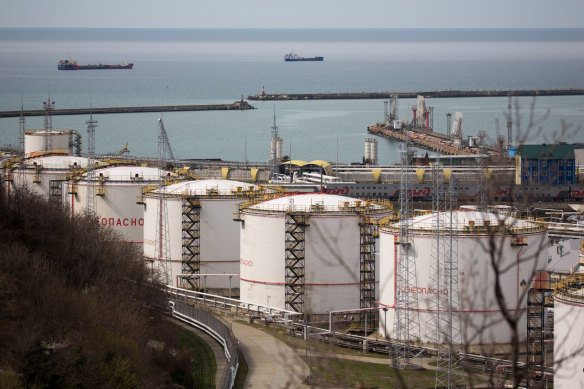The deterioration in the trade balance has put the Russian rouble under acute pressure. After being one of the best performers last year – after initially plummeting when the invasion was launched – it has been one of the worst this year, depreciating around 20 per cent. One Russian rouble was worth about US1.4¢ at the start of the year. It is now worth around US1.1¢.
It’s been particularly volatile in recent weeks, with the aborted “March to Moscow” by Yevgeny Prigozhin’s Wagner troops triggering the most recent fall to its lowest levels in 15 months. It has stabilised this week, but is still outside the range of 80 to 90 roubles to the US dollar targeted by Russia’s central bank.
The sanctions and the withdrawal of foreign investors from Russia’s financial markets means the value of the rouble is driven almost entirely by the current account flows, which suggests it might have further to depreciate and raises the prospect that, without intervention, it could feed into an inflationary spiral, although inflation in Russia, after an initial spike last year, has been in the low single digits within a war-affected economy.
The rouble’s value hasn’t been helped by a steady leakage of capital, with a burst of capital flight after the Wagner mutiny, as Russians continue to shift their savings offshore despite the capital controls imposed last year. There’s been an exodus of about $US45 billion ($66.9 billion) since March last year, with a fresh surge after the Wagner revolt.
Loading
While Russian officials appear unfussed by the shrinkage in the current account and the depreciation of the rouble, they have taken some action.
There’s an across-the-board 10 per cent cut planned for government spending, an expectation that the central bank will raise interest rates, and the finance ministry has been selling foreign currency reserves, mainly China’s yuan, to raise cash to supplement the diminished energy revenues and support the currency.
The finance ministry has said it plans to sell foreign currency reserves worth about 35 billion roubles ($580 million) over the next month, after previously announcing it would sell 74.6 billion roubles-worth between June 6 and July 7.
Russia has accumulated significant holdings of China’s yuan and India’s rupees by conducting trade with those countries in their own currencies to avoid having to trade in the US dollars in which commodities trading is usually conducted. (Russia has been booted out of the dollar-dominated SWIFT global messaging system that underpins most global financial transactions and most of its reserves held offshore, which are predominantly in US dollars, frozen).
Despite several attempts by the Saudis and Russia to push up oil prices by reducing production, the weakness in the global economy has kept them below $US80 a barrel.
Russia’s oil that is carried by Western ships insured by Western insurers is subject to the $US60 a barrel cap. While it has assembled a large “gray fleet” of its own, the existence of the cap means buyers can demand discounts to the global price and re-routing its sales from Europe to Asia adds significantly to the costs.

The European and G7 sanctions on Russian energy implemented last December have savaged Russia’s revenues.Credit: Bloomberg
Russia needs higher oil prices for its unsanctioned oil and/or higher volumes of the capped price oil if it is to stabilise its current account and currency and sustain the funding for the war in Ukraine without decimating a domestic economy that has held up surprisingly well and destabilising the Putin regime in the process.
China’s spluttering economy and the squeeze on developed economy growth being exerted by the higher interest rates imposed to combat inflation, won’t help Russia’s cause.
Loading
The rouble, now that it provides a relatively clean insight into the external capital flows of an export-reliant economy, will be a good barometer of Russia’s condition. It’s showing significant pressure.
The Business Briefing newsletter delivers major stories, exclusive coverage and expert opinion. Sign up to get it every weekday morning.
Stay connected with us on social media platform for instant update click here to join our Twitter, & Facebook
We are now on Telegram. Click here to join our channel (@TechiUpdate) and stay updated with the latest Technology headlines.
For all the latest Business News Click Here
For the latest news and updates, follow us on Google News.
